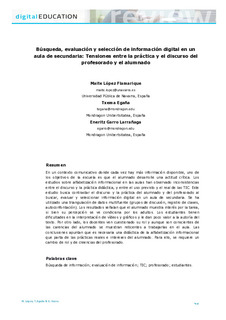| dc.rights.license | Attribution-NonCommercial-NoDerivatives 4.0 International | * |
| dc.contributor.author | Egaña, Txema | |
| dc.contributor.author | Garro, Eneritz | |
| dc.contributor.other | López Flamarique, Maite | |
| dc.date.accessioned | 2020-06-23T15:58:12Z | |
| dc.date.available | 2020-06-23T15:58:12Z | |
| dc.date.issued | 2019 | |
| dc.identifier.issn | 2013-9144 | en |
| dc.identifier.other | https://katalogoa.mondragon.edu/janium-bin/janium_login_opac.pl?find&ficha_no=154335 | en |
| dc.identifier.uri | https://hdl.handle.net/20.500.11984/1698 | |
| dc.description.abstract | En un contexto comunicativo donde cada vez hay más información disponible, uno de
los objetivos de la escuela es que el alumnado desarrolle una actitud crítica. Los
estudios sobre alfabetización informacional en las aulas han observado inconsistencias
entre el discurso y la práctica didáctica, y entre el uso previsto y el real de las TIC. Este
estudio busca contrastar el discurso y la práctica del alumnado y del profesorado al
buscar, evaluar y seleccionar información digital en un aula de secundaria. Se ha
utilizado una triangulación de datos multifuente (grupos de discusión, registro de clases,
autoconfontación). Los resultados señalan que el alumnado muestra interés por la tarea,
si bien su percepción se ve condiciona por los adultos. Los estudiantes tienen
dificultades en la interpretación de vídeos y gráficos y le dan poco valor a la autoría del
texto. Por otro lado, los docentes ven cuestionado su rol y aunque son conscientes de
las carencias del alumnado se muestran reticentes a trabajarlas en el aula. Las
conclusiones apuntan que es necesaria una didáctica de la alfabetización informacional
que parta de las prácticas reales e intereses del alumnado. Para ello, se requiere un
cambio de rol y de creencias del profesorado. | es |
| dc.description.abstract | In a communicative context where more and more information is available, one of the
objectives of the school is for the students to develop a critical attitude. Studies on
information literacy in classrooms have observed inconsistencies between discourse and
didactic practice, and a significant distance between the intended and actual use of ICT
in class. Therefore, this study seeks to contrast the discourse and practice of both
students and teachers when searching, evaluating and selecting digital information in a
secondary classroom. This is a case study that has used a multi-source data
triangulation (discussion groups, activity record, self-confrontation). The results indicate
that the students show interest in the task, although their perception is conditioned by
the adults. Students have difficulties in interpreting videos and graphics and give little
value to the authorship of the text. On the other hand, teachers have questioned their
role and although they are aware of the lacks of students, teachers are reluctant to work
in the classroom. The conclusions suggest that it is necessary to develop a didactic of
informational literacy based on the real practices and interests of the students. For this,
a change of role and beliefs of the teaching staff is required. | en |
| dc.language.iso | spa | en |
| dc.publisher | Universitat de Barcelona | en |
| dc.rights | © Los autores | en |
| dc.rights.uri | http://creativecommons.org/licenses/by-nc-nd/4.0/ | * |
| dc.subject | Búsqueda de información | es |
| dc.subject | Evaluación de información | es |
| dc.subject | TIC | es |
| dc.subject | Profesorado | es |
| dc.subject | Estudiantes | es |
| dc.subject | Information search | en |
| dc.subject | Information evaluation | en |
| dc.subject | ICT | en |
| dc.subject | Teachers | en |
| dc.subject | Students | en |
| dc.title | Búsqueda, evaluación y selección de información digital en un aula de secundaria: Tensiones entre la práctica y el discurso del profesorado y el alumnado | es |
| dc.title.alternative | Search, evaluation and selection of digital information in a secondary classroom: Tensions between the practice and the discourse of teachers and students | en |
| dcterms.accessRights | http://purl.org/coar/access_right/c_abf2 | en |
| dcterms.source | Digital Education Review. | en |
| local.contributor.group | Berrikuntza eta esku-hartzea gizarte kulturanitz eta eleanitzetan | eu |
| local.description.peerreviewed | true | en |
| local.description.publicationfirstpage | 36 | en |
| local.description.publicationlastpage | 50 | en |
| local.identifier.doi | https://doi.org/10.1344/der.2019.36.36-50 | en |
| local.contributor.otherinstitution | https://ror.org/02z0cah89 | es |
| local.source.details | Nº 36. pp. 36-50. | eu_ES |
| oaire.format.mimetype | application/pdf | |
| oaire.file | $DSPACE\assetstore | |
| oaire.resourceType | http://purl.org/coar/resource_type/c_6501 | en |
| oaire.version | http://purl.org/coar/version/c_970fb48d4fbd8a85 | en |








